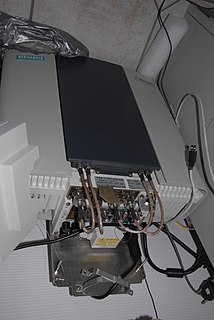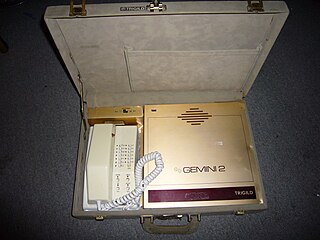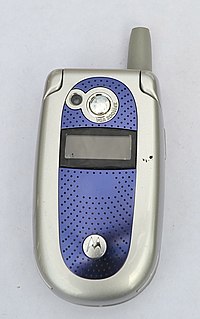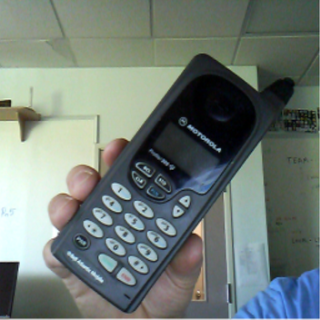
Advanced Mobile Phone System (AMPS) was an analog mobile phone system standard developed by Bell Labs, and officially introduced in the Americas on October 13, 1983, Israel in 1986, Australia in 1987, Singapore in 1988, and Pakistan in 1990. It was the primary analog mobile phone system in North America through the 1980s and into the 2000s. As of February 18, 2008, carriers in the United States were no longer required to support AMPS and companies such as AT&T and Verizon Communications have discontinued this service permanently. AMPS was discontinued in Australia in September 2000, in Pakistan by October 2004,, in Israel by January 2010, and Brazil by 2010.

Base station is – according to the International Telecommunication Union's (ITU) Radio Regulations (RR) – a "land station in the land mobile service."

A cell site, cell tower, or cellular base station is a cellular-enabled mobile device site where antennae and electronic communications equipment are placed—typically on a radio mast, tower, or other raised structure—to create a cell in a cellular network. The raised structure typically supports antenna and one or more sets of transmitter/receivers transceivers, digital signal processors, control electronics, a GPS receiver for timing, primary and backup electrical power sources, and sheltering.

A base transceiver station (BTS) is a piece of equipment that facilitates wireless communication between user equipment (UE) and a network. UEs are devices like mobile phones (handsets), WLL phones, computers with wireless Internet connectivity. The network can be that of any of the wireless communication technologies like GSM, CDMA, wireless local loop, Wi-Fi, WiMAX or other wide area network (WAN) technology.

A cellular network or mobile network is a communication network where the last link is wireless. The network is distributed over land areas called "cells", each served by at least one fixed-location transceiver, but more normally, three cell sites or base transceiver stations. These base stations provide the cell with the network coverage which can be used for transmission of voice, data, and other types of content. A cell typically uses a different set of frequencies from neighbouring cells, to avoid interference and provide guaranteed service quality within each cell.

A car phone is a mobile radio telephone specifically designed for and fitted into an automobile. This service originated with the Bell System, and was first used in St. Louis on June 17, 1946.

The Improved Mobile Telephone Service (IMTS) was a pre-cellular VHF/UHF radio system which linked to the PSTN. IMTS was the radiotelephone equivalent of land dial phone service. Introduced in 1964, it replaced Mobile Telephone Service (MTS) and improved on most MTS systems by offering direct-dial rather than connections through a live operator.

The effect of radiation from mobile phones and other wireless electronic devices on human health is a subject of interest and study worldwide, as a result of the enormous increase in mobile phone usage throughout the world. As of 2015, there were 7.4 billion phone subscriptions worldwide, though the actual number of users is lower as many users own more than one mobile phone. Mobile phones use electromagnetic radiation in the microwave range. Other digital wireless systems, such as data communication networks, produce similar radiation.

DynaTAC is a series of cellular telephones manufactured by Motorola, Inc. from 1983 to 1994. The Motorola DynaTAC 8000X commercial portable cellular phone received approval from the U.S. FCC on September 21, 1983. A full charge took roughly 10 hours, and it offered 30 minutes of talk time. It also offered an LED display for dialing or recall of one of 30 phone numbers. It was priced at $3,995 in 1984, its commercial release year, equivalent to $9,634 in 2018. DynaTAC was an abbreviation of "Dynamic Adaptive Total Area Coverage."

The Motorola Razr was a series of mobile phones by Motorola, part of the 4LTR line. The V3 was the first phone released in the series and was introduced in July 2004 and released in the market in the third quarter of 2004. The V3 model was followed soon thereafter by the much improved V3i with a collaboration with Apple Inc. for iTunes to be built-in.

The Motorola International 3200 was the first digital hand-held mobile telephone introduced in 1992, along with the more compact 5200, 7200 and 7500 "flip phones" introduced in 1994. It was preceded by the International 1000 and 2000 GSM phones, quite big, and although being the first GSM portable phones, they were not GSM certified, therefore couldn't be officially connected to the network.
Motorola Mobility LLC, marketed as simply Motorola, is a consumer electronics and telecommunications company owned by technology firm Lenovo Group Limited. The company primarily manufactures smartphones and other mobile devices running the Android operating system developed by Google.

Martin "Marty" Cooper is an American engineer. He is a pioneer in the wireless communications industry, especially in radio spectrum management, with eleven patents in the field.

The Motorola E815 is the successor to the V710. The E815 is known for having superb reception and has received a warm welcome from many phone enthusiasts disappointed with the shortcomings of the V710. However, it is now old and outdated. It includes the following features:
The Motorola E770 mobile phone is a 3G phone that operates primarily on the third generation phone network; however, it can be downscable to GPRS 2.5 and below if required.

The V535 is a model of cell phone from Motorola. It has limited Bluetooth capabilities and a 0.3 megapixel digital camera with 4X digital zoom and video capabilities. Branded versions were released for Vodafone, T-Mobile and Orange called the V550, E550 and V545 respectively.
The Motorola Razr2 (often stylized as RAZR2) is a series of clamshell/flip mobile phones from Motorola, and is one of the series in the 4LTR line. It is the successor to the popular Razr series. The Razr2 is 2 mm thinner than its predecessor but slightly wider. Some versions feature Motorola's MotoMagx operational platform, based on the MontaVista Linux OS. The Razr2 was made available on every US carrier, and EVDO, GSM and HSDPA versions of it were released by late 2007.

The Motorola Profile 300e is a mobile phone that was manufactured by Motorola in 1996. The Profile had the Motorola MicroTAC's battery and antenna. The "e" at the end of the name means that it had all of the special features as well as extended display. The phone had a "slim" 6V Nickel-Metal Hydride battery and a regular battery. With the slim battery, the phone was about an inch thick. It had a built-in antenna that was 5 inches long. For making calls, the phone had a SND button, and to end calls it had an end button. The Profile was not a very popular cell phone.















